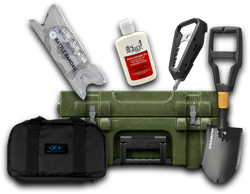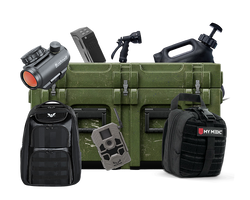
Blade Profiles
There are over 30 types of blades on the market these days - each with different sizes and shapes and use. We have narrowed down some of the most essential and useful blade types so that you can easily choose the one that suits your needs.
Sheep’s foot:
What was once in essence a tool to help maintain your herd of sheep, the Sheep’s Foot style of blade has become quite prominent today as an everyday carry or a daily use on the farm. This blade can do it all. The blade has a straight edge with a solid, slightly curving spine to help you maintain thumb pressure. The curve enables force on a small point, and this way, it can easily slice, cut, or chop things. However, stabbing is most likely out of the question due to the blade having no real sharp point; by design.
Karambit:
A style of blade that has deep roots in Southeast Asia. Rumor has it that this style of blade was inspired and designed based around the claws of a tiger because it has a small, curved blade that could be considered to look like a claw or hook. The handle is also an important part of this design as it curves to meet the blade and, in essence, will become an extension of your arm as you learn to use this blade. This is most often considered a self-defense weapon, and it is excellent at slashing or hooking an opponent.
Drop point :
The Drop Point blade is one of the most common blade styles used today. It is one of the most famous all-purpose and useful blade shapes around and has an excellent cutting edge for slicing. The drop point has a strong convex spine that curves well towards the point of the knife. Its point is sharp and controllable, but it is more suitable for slicing rather than piercing. Usually, you can see this blade style on Swiss army pocket knives. We featured two drop point blades in our July General Crate and one in our July Captain Crate.
Tanto Point :
Tanto blade is another one of unique and robust blade designs. You can trace this blades roots back to ancient Japan because it is modeled after the “Tanto” Short sword that Samurai would often carry into battle. The Tanto has a sharp and robust angled edge that follows the straight edge of the blade. Its point is thick and extremely strong, with no chances of breaking. The blade turns from a straight edge to an angled edge leading to the point which make this shape makes extremely strong and controllable. It is not intended for cutting but is extremely effective at piercing.
Clip point:
The Clip Point blade was made immensely popular by the classic bowie knife. Being an American classic since the 1800s, this blade style is best described as being “clipped”. This leaves a concave shape near the front of the blade that curves into a point. With this sharp point, this style is often favored for dealing with those small details in your wood carving or other delicate cutting jobs. Don’t let that fool you though. This knife is excellent at piercing strong or thick objects.
Spear point:
The Spear Point blade has the design and likeness to a spear, or one could also classify this within the dagger or dirk type category. This can be a single or double-edged blade depending on the type of design. The blade will always be symmetrical with a needle like point, and it excels at one vicious thing: purposeful and decisive thrusting and stabbing.
Kukri Style:
The Kukri style blade originated from Nepal and India. It is a strong classic and fan favorite of many survivalists today. With extreme utility overall, it has been used through history in the military, but is also useful on farms or while out in the brush. This blade does it all. From shoveling to chopping and clearing, it is the go to blade for anyone that plans on being in the elements for an extended period of time.
Hawkbill:
A Hawkbill blade is most commonly used to cut rounded organic material, such as smaller sticks or branches, mushrooms, or fruit in an orchard. You will also see this as a common blade style used to cut level surfaces such as carpet or even sod! This is due to how deep the curve of this blade goes.Share this article







